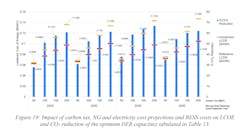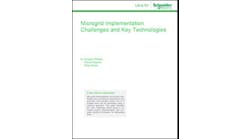Campus Microgrid With Small Modular Nuclear Reactor Could Yield 63.5% Reduction in Carbon: Study
As part of its effort to decarbonize its campus, the University of Illinois Urbana-Champaign (UIUC), partnering with software company Xendee, released a study finding that a microgrid with a small modular nuclear reactor (SMR) could yield up to a 63.5% reduction in CO2 emissions under a high carbon-tax scenario.
The SMR-based microgrid would be cost-competitive with grid power in a scenario that includes a modest carbon tax, said Timothy Grunloh, principal research scientist at the university.
Balancing cost, resilience and decarbonization on college campuses
One of the biggest challenges in higher education today is balancing three often competing goals–lowering energy costs, providing resilience and reducing carbon emissions. In the UIUC study, the Xendee platform looked at how different scenarios affect these issues.
Many universities, like UIUC, have fossil-based district heating systems and aggressive climate goals, said Grunloh. The university’s goal is to be net zero by 2050.
UIUC isn’t the only university looking into SMRs. For example, Natura Resources plans to locate an advanced molten salt reactor at Abilene Christian University.
UIUC power plant yields 80% of carbon emissions
Right now, UIUC has a district heating campus with a combined heat and power (CHP) microgrid on site – fueled by natural gas, coal and fuel oil – that can meet 100% of campus steam needs, as well as 20% to 50% of electricity needs. The rest of the electricity comes from the grid.
Average demand for the campus is 50 MW of steam and 60 MW of electricity. The university also has 12 MW and 5 MW of solar projects plus power purchase agreements with a nearby wind farm, the Rail Splitter Wind Farm. The University’s existing power plant accounts for about 80% of its carbon emissions, said Reynaldo Guerrero, principal engineer at Xendee.
“The main goal is to replace the plant with new technology. Small nuclear reactors can be operated as combined heat and power to satisfy heat and electricity needs,” Guerrero said.
University expects increased energy demand from AI
The campus, which serves 59,000 students, includes dorms, dining halls, office buildings and athletic facilities and houses the Blue Waters supercomputer. The university has plans to add another supercomputer focused on artificial intelligence development, which will boost demand for energy.
The study is intended to shed light on the benefits of SMR for academic, industrial, data center and other types of applications, said Jim Reilly, consultant for the Department of Energy’s Office of Electricity Microgrid Program, which supported the project.
The important role of carbon taxes
As part of the effort, Xendee looked at various carbon tax scenarios. In a grid-connected case, SMR would be competitive with grid power with a carbon tax of about $150 per metric ton, said Grunloh. Without a carbon tax, SMR wouldn’t be competitive,” he said.
Adding energy storage to the microgrid would reduce the size of the SMR by 20% and cut the cost of the SMR by 20%, Grunloh said.
Since SMRs aren’t expected to be available until 2030 or so, the study modeled ways to decarbonize using DERs in the short term. The DERs include solar, batteries and green hydrogen-based fuel cells, said Guerrero.
“The study shows that a carefully optimized mix of SMRs, BESS (battery energy storage systems) and other renewable energy sources can meet the campus's energy demand effectively while minimizing costs and emissions,” the study said. “The scenarios modeled demonstrate the importance of strategic planning and investment in diverse energy technologies to achieve optimal results.”
In the short-term, university eyes hydrogen fuel cells
The university might start with hydrogen fuel cells, then use a SMR when the technology is available, said Guerrero.
The projected cost for SMRs in 2030 is about $8,000 per kW, he said. By 2050, the typical median value could drop to about $4,000 per kW.
Small fuel cells now cost about $4,000 per kW, he said.
“A technology like a hydrogen fuel cell would be ideal,” Guerrero said. Because the university has a supercomputer and a data center, the fuel cell would be a better option than solar and storage. That’s because large numbers of solar and batteries would be needed to meet decarbonization goals, he said. Fuel cells, like SMRs, are attractive because they require less space and can operate 24/7.
How safe are SMRs?
Microgrid industry members have expressed skepticism about using SMRs in urban areas because of safety concerns.
Check out our Nuclear Microgrids E-Book
Stories on the Small, Modular and Reactive Future
Grunloh said that advanced reactors like SMRs are safer because they rely on passive processes to remove heat. In addition, the advanced fuels often keep radioactive products inside the fuel, he added.
In spite of the view that SMRs are safer than larger nuclear plants, a number of issues can slow deployment of SMRs, said the study.
SMR licensing, construction and commissioning issues
“Although advanced nuclear technologies are being designed to be constructed much faster and cheaper than prior nuclear megaprojects, they are still anticipated to have nontrivial licensing, construction and commissioning phases,” the study said. Companies and organizations that want to transition to SMRs need to make important decisions about financing, procurement, building infrastructure and other issues.
A levelized cost of energy analysis in the study suggested that even though SMR initial costs are high, the long-term benefits of decarbonization and resilience “make them a viable option for the UIUC microgrid.”
“A lot depends on how you value decarbonization and resilience,” said Grunloh.








